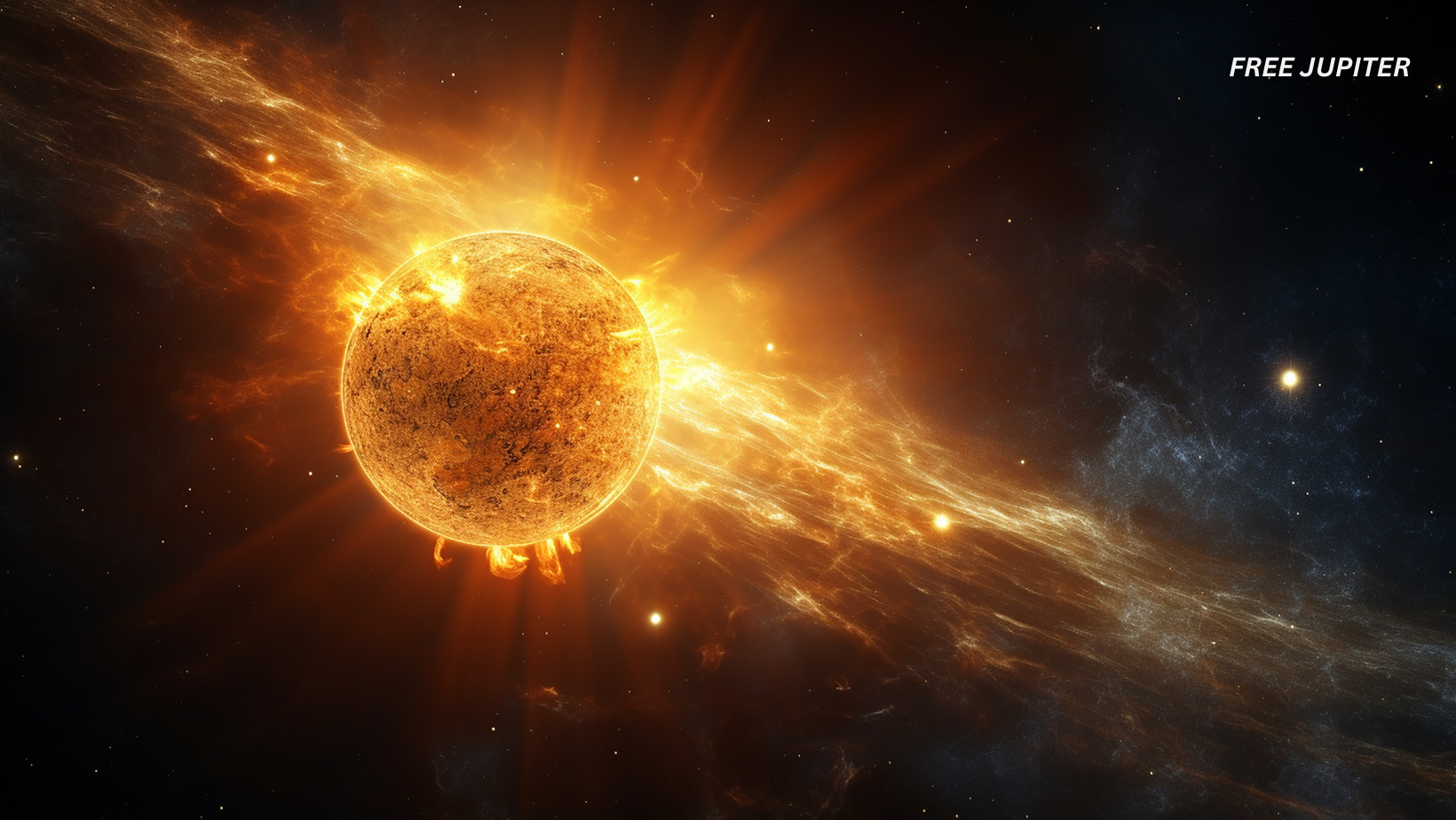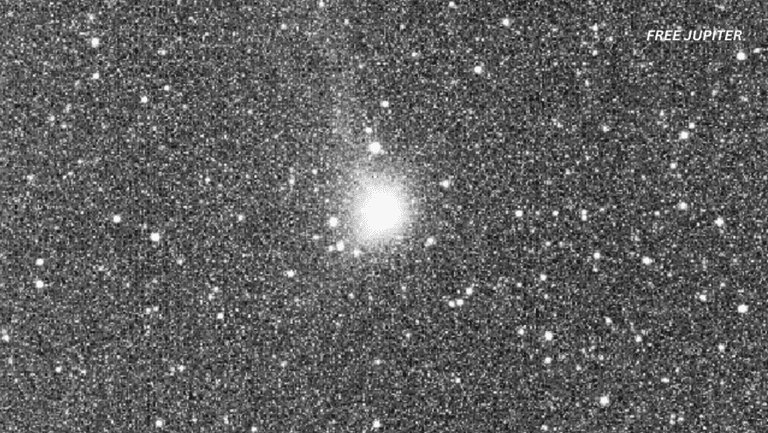Friendly Note: FreeJupiter.com shares general info for curious minds 🌟 Please fact-check all claims—and always check health matters with a professional 💙
In a landmark achievement for astronomy, scientists have, for the first time, directly detected water ice encircling a star that bears a striking resemblance to our own Sun. This discovery, made possible by the James Webb Space Telescope (JWST), offers a vivid glimpse into the early processes of planetary system formation and the crucial role of water in shaping worlds. The star in question, HD 181327, lies roughly 155 light-years away and is surrounded by a vast debris disk rich in icy material reminiscent of the Kuiper Belt in our Solar System.
HD 181327: A Young Solar Analog with a Dynamic Debris Disk
HD 181327 is a relatively young star, estimated to be about 23 million years old, a mere infant compared to the 4.6 billion-year age of our Sun. Unlike our mature Solar System, HD 181327 is still enveloped by a circumstellar debris disk—a sprawling ring of dust, ice, and minor bodies such as asteroids and comets. This disk is often described as an exo-Kuiper Belt, a distant reservoir of icy objects analogous to the Kuiper Belt beyond Neptune in our own system.
The debris disk extends roughly from 85 to 113 astronomical units (AU) from the star, with 1 AU being the average distance between Earth and the Sun. This region is cold enough for water to exist predominantly in solid form, making it an ideal laboratory for studying water ice in environments where planets are still coalescing.
The Role of JWST and Near-Infrared Spectroscopy
The breakthrough detection was achieved using JWST’s Near-Infrared Spectrograph (NIRSpec), which can analyze the light reflected and emitted by dust and ice particles in exquisite detail. The team, led by Chen Xie of Johns Hopkins University, identified a distinctive broad absorption feature centered around 3 micrometers (μm) in wavelength, a signature characteristic of solid-state water ice.
More notably, they observed a sharp Fresnel peak at 3.1 μm—an optical phenomenon caused by the reflection and refraction of light within large, crystalline water-ice grains. This peak is a hallmark of crystalline ice particles larger than one millimeter, similar to those found in Saturn’s rings and Kuiper Belt objects (KBOs) in our Solar System.
The presence of crystalline water ice is significant because it implies a relatively stable and cold environment where ice grains can form and persist without being rapidly destroyed or sublimated by stellar radiation.
Water Ice Distribution and Mass Fractions
The JWST data revealed a fascinating gradient in water ice concentration across the debris disk. In the outermost regions, around 113 AU from the star, water ice makes up approximately 21% of the disk’s mass. This high fraction suggests a substantial reservoir of icy material, likely composed of numerous small bodies akin to comets or KBOs.
Moving inward toward 85 AU, the water ice fraction drops sharply to about 0.1%. At intermediate distances near 90 to 105 AU, the ice fraction measures around 8 to 14%. Closer to the star, within the inner disk regions, water ice is nearly absent. This pattern is consistent with the effects of ultraviolet radiation from HD 181327, which vaporizes ice particles near the star, and the possibility that water is locked inside rocky planetesimals, making it undetectable as free ice.
These findings illustrate a dynamic environment where icy grains are continually destroyed and replenished, likely through ongoing collisions among larger icy bodies. Such collisions release fresh dust and ice particles, maintaining the disk’s observable water-ice signature.
A System Mirroring Our Own Kuiper Belt
The spectral characteristics of the water ice in HD 181327’s debris disk closely match those of icy KBOs in the Solar System. After accounting for other dust components such as iron sulfide and olivine—minerals commonly found in comets and asteroids—the water-ice spectrum from HD 181327 shows striking similarities to that of known Kuiper Belt objects.
This resemblance strengthens the analogy between HD 181327’s debris disk and our Solar System’s Kuiper Belt, suggesting that the processes governing the formation and evolution of icy bodies may be universal. The presence of a broad, dust-free gap between the star and the debris disk further echoes the architecture of our Solar System, where the inner planets orbit within a relatively clear zone separated from the outer icy regions.
Implications for Planet Formation and Water Delivery
Water ice is a fundamental ingredient for planet formation and the emergence of habitable environments. The discovery of crystalline water ice in HD 181327’s debris disk confirms that icy materials are abundant in young planetary systems and likely play a pivotal role in delivering water to terrestrial planets.
In our Solar System, it is believed that comets and KBOs contributed significantly to Earth’s oceans by transporting water from the outer regions inward. The HD 181327 system appears to be undergoing a similar process, with icy bodies colliding and potentially migrating inward over hundreds of millions of years, delivering water and other volatiles essential for life.
The detection of water ice also provides insight into the physical conditions within the debris disk. The presence of large crystalline ice grains indicates low temperatures and relatively gentle collisional processes, allowing ice to survive and accumulate. This contrasts with the inner disk regions, where harsher radiation environments prevent ice from persisting on dust grains.
Additional Dust Components and Disk Composition
Beyond water ice, the JWST observations identified other materials in the debris disk, including iron sulfide and olivine. Iron sulfide is known from micrometeorite and comet samples in our Solar System, while olivine is a common silicate mineral found in a variety of planetary materials.
These components contribute to the overall composition of the dust and minor bodies in the disk, influencing the disk’s thermal properties, reflectance spectra, and the potential for planetesimal formation. The mixture of icy and rocky materials mirrors the diversity seen in Solar System bodies, reinforcing the idea that HD 181327’s debris disk is a rich and complex environment.
The Dynamic Nature of HD 181327’s Debris Disk
The debris disk is not a static structure but a highly active zone where collisions among icy bodies continually generate fresh dust and ice particles. These collisions are essential for replenishing the disk’s material, which would otherwise be depleted over time by radiation pressure and stellar winds.
Christine Chen from the Space Telescope Science Institute, a co-author of the study, emphasized the system’s activity, noting that “HD 181327 is a very active system, with regular collisions releasing particles of dusty water ice that JWST can detect with great sensitivity.”
This ongoing dynamism offers a unique opportunity to observe planetary system evolution in action, providing clues about the timescales and mechanisms by which planets and minor bodies form and interact.
Read more: Astronomers Are Baffled by a Space Object Flashing in Both Radio Waves and X-Rays
Broader Context and Future Research
This discovery builds on earlier observations from NASA’s Spitzer Space Telescope in 2008, which hinted at the presence of water ice in HD 181327’s disk but lacked definitive confirmation. JWST’s advanced instrumentation has now provided unambiguous evidence, opening new avenues for studying water in exoplanetary systems.
Looking ahead, astronomers plan to use JWST and upcoming telescopes to survey other young stars with debris disks, aiming to map the distribution of water ice and other volatiles across a range of stellar environments. Such research will deepen our understanding of how common water-rich systems are in the galaxy and what conditions favor the emergence of habitable worlds.
The detection of water ice around a Sun-like star like HD 181327 not only enriches our knowledge of planetary system formation but also fuels the quest to understand the origins of life’s essential ingredients beyond Earth.
In summary, the first direct observation of water ice in the debris disk around HD 181327 marks a milestone in astrophysics. It confirms that icy materials, crucial for planet formation and potentially for life, are present in young planetary systems similar to our own. The system’s resemblance to the Kuiper Belt and its dynamic, evolving nature provide a compelling parallel to the early Solar System, offering a cosmic mirror that reflects the processes that shaped our planetary neighborhood billions of years ago.










